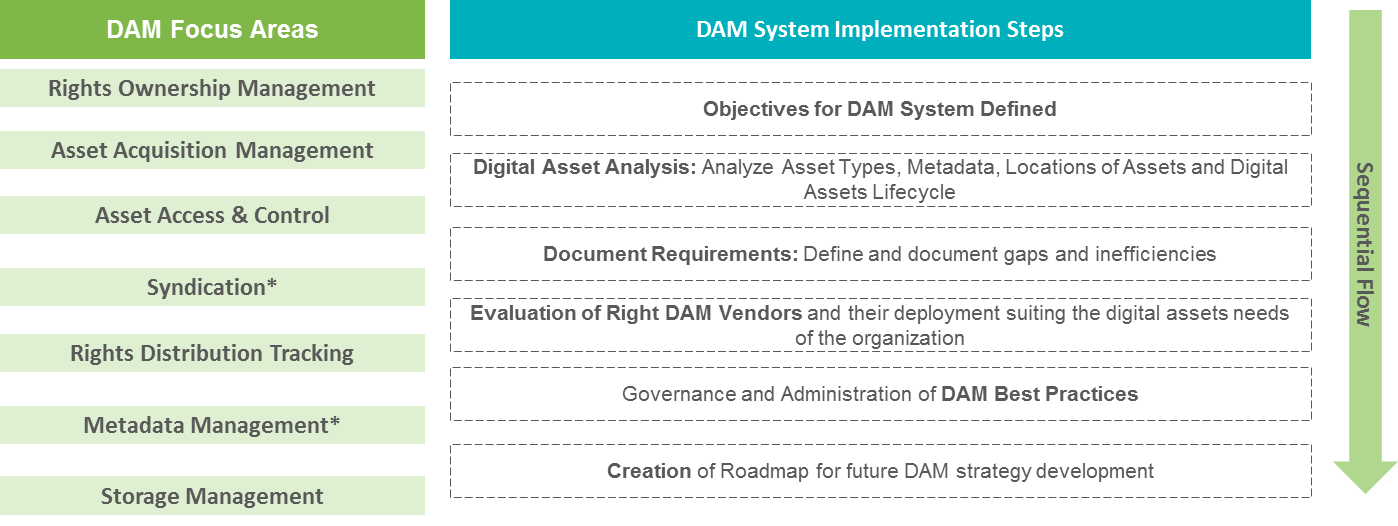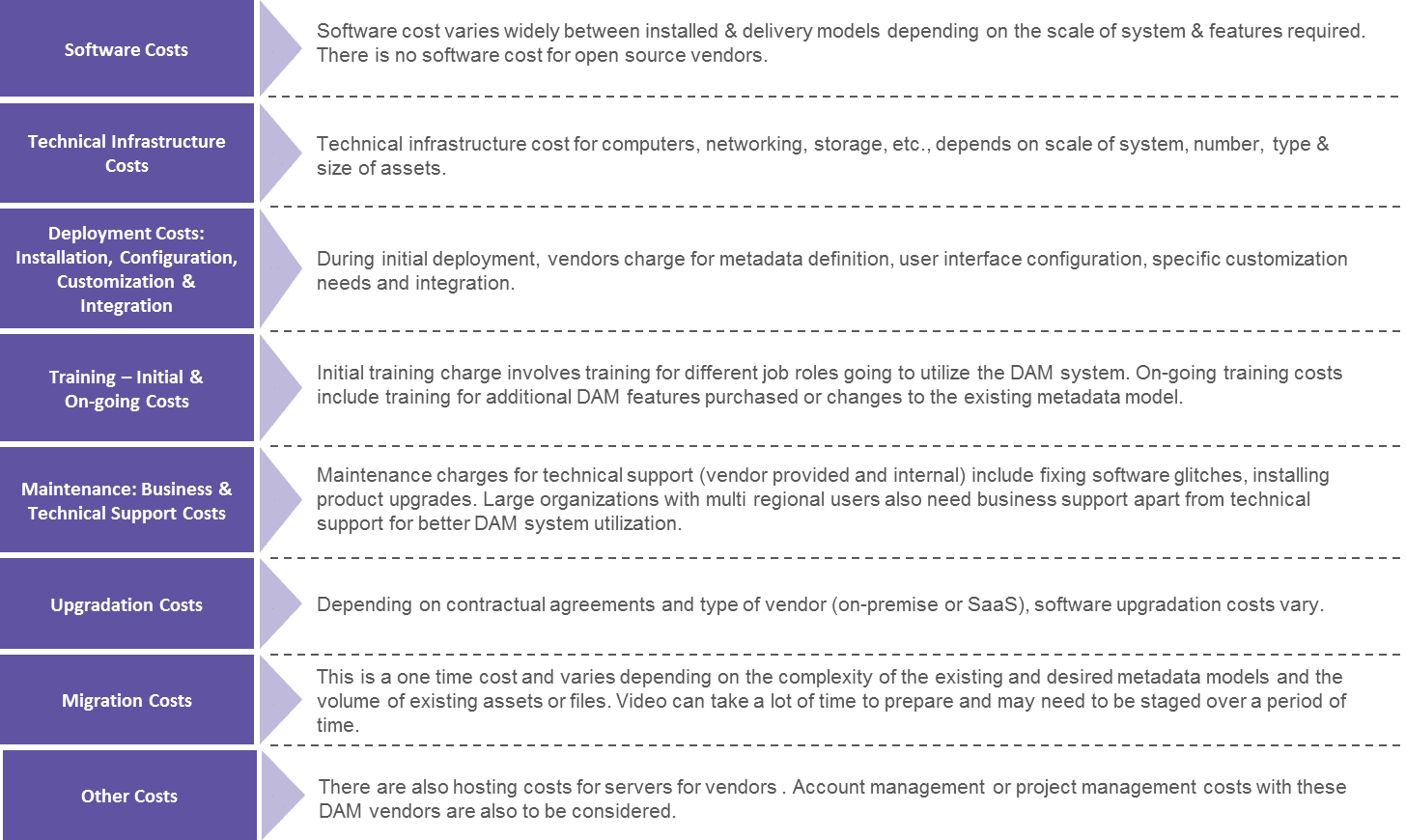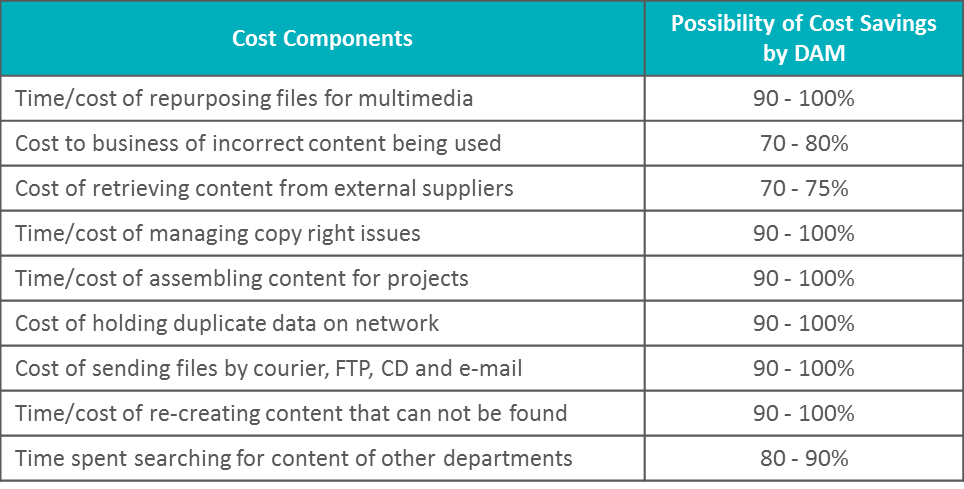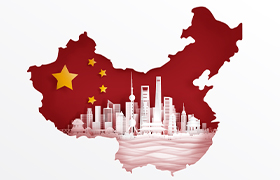
Implemention of Digital Asset Management System in Advertising Production

Abstract/Business Case
1 Introduction
Production accounts for 20–25 percent of the total advertising expenditure of clients. Media contributes to the majority of these expenses because it is the channel of communication between the advertiser and consumer. However, since advertisement production is a tactical job, it accounts for a lower share of the overall cost. This whitepaper focuses on approaches that can help reduce the advertising production costs, with major focus on digital asset management (DAM).
2 Main
DAM can be used for storage of production content by either using software in-house or outsourcing to third-party vendors in order to minimize the cost of production as well as leverage the production decoupling services.
3 Recommendation
DAM is the way forward for all advertising, including the tactical categories like production.
Problem Statement
Advertising is one of the most dynamic industries constantly changing at the supplier land space level and in technology adoption and consumer engagement techniques. Media is seen as the most crucial spending point in advertising since it is the platform that brings the consumer closer to the advertiser in order to understand the brand, and, thus, trigger the purchase decision through improved brand positioning.
Creative advertising was always given priority (with 40–45 percent of the total advertising budget), since creative and art directors were the key persons behind the brand message and content in an ad for a marketer. In the early days, production was considered a part of the advertising agency services, where marketers engaged with advertising agencies for end-to-end concept and campaign development. However, when procurement identified the cost benefit of decoupling production services for production companies, it slowly created a trend in the production space. Thus, more marketers began to engage third-party production houses to cater to their production requirements.
In addition, owing to the reduction in advertising budgets, buyers developed asset management systems to form a repository of their creative works, but since production was considered a crucial category, it was given lower importance owing to its tactical nature.
This whitepaper highlights the advantages of DAM and shows how marketers can use this in the production space and enjoy cost advantage in the years to come.
Overview of DAM Systems
DAM is a process by which buyers can organize, store, and retrieve rich media and manage digital rights and permissions. The rich media assets include advertising content, ad images, background music, videos, animations, and campaign reports that can be used for future reference

Sources: PE1, Secondary sources (digitalassetmanagementnews.org), Supplier Interaction.
Types of Tools: DAM can be managed by a buyer in two ways, by engaging a cloud-based provider through annual or quarterly subscriptions, and by developing a proprietary tool on a perpetual or term licensing basis customized to the marketers’ requirements
Cost areas in implementing a DAM system

Sources: PE1, North Plains Website, Supplier Interaction
Benefits of DAM System Usage
- Savings in data logistics: The organization migrates from physical storage (like sending marketing collateral CDs and DVDs to partners) to enabling centralized digital access to the concerned marketing professionals.
- Faster access to digital assets: A well-indexed repository of all marketing assets already formatted and converted to appropriate formats (like converting a 30-MB file to a 200-KB file) reduces the cost of search time and lost or misplaced work.
- Workflow optimization: An integrated asset management with fast content discovery, role-based access control to assets, and team-informed version control (marketing collateral versions) of assets enables an efficient workflow process that minimizes the expenditure and time cost of incorrect, out-of-date, or incomplete content.
- Brand loyalty and consistency: The shift in working style of marketing departments in an organization from isolated, disparate entities to enterprise-wide consistent marketing and branding initiatives.
- There are also benefits of owning digital assets by clients, such as no loss of brand and collaterals while switching agencies. The main benefits are avoidance of duplication of work (basically, reduction in time and resource) and better adaptation of already-owned assets.
Another major hidden value proportion that marketers fail to identify is the major boon of helping them in ROI calculation. The ROI of DAM implementation can be classified into both hard and soft dollar costs involving process improvement, cost reduction, revenue generation, new profit centres, and brand protection.
Here are a few cost components and their probable savings that could be created by investment in a DAM system:

Source: Supplier interaction.
Implementing DAM in the Advertising Production Category
Production process flow and DAM’s role
Production comprises mainly three stages—pre-production, production, and post-production—by which advertisements are distributed to their respective formats across various channels.

- Pre-production requires content from the advertising agency partner outlining the script, planning locations, cast, transportation, shooting requirements, etc. An asset platform helps to simplify this process by ensuring that all the content and data are posted on a common platform viewed by different people across the project. This simplifies approvals and continuous feedback, and ensures that no data are lost during communication at any point in time.
- Production, which includes shoot and video graphics and animation, is the key process. Shooting updated approvals are smoother. A repository of brand animation and graphics can be leveraged from the database; this reduces the time and effort to develop and edit the same.
- Post-production is also benefited in creating end-formatted files and sending them to various channels. Here, the tool creates a platform for the creative directors, marketers, and other team members to review the files from different places and ensure that their comments are entered into the platform, and to make suitable changes; these remain as a record and also saves the loss of time from back and forth reviews.
Apart from these regular production activities, buyers can avail some value-added benefits by using DAM in their production system:
- Access data from any location: The major advantage of DAM is that the personnel can view their working on the campaign from any location and provide feedback to ensure easy approvals at every stage. This could be done just through a log, thus making the system easier and saving lead time to the market.
- Storage of data for future use: The brand content, animation, older campaigns, and work done for the same are stored in a common repository that can be viewed, reused, and leveraged at any given point in time.
- Usage of campaign data for promotions at other locations: A campaign or related production content used for a specific campaign can be leveraged for other campaigns either for the same region or for other locations of the marketer. This saves cost of production and ensures reusability of the campaign.
- Identify partner agencies to leverage globally: Marketers have global contacts with holding groups that are leveraged only in the main client locations. Access to these data can help regional managers leverage the contact or establish relationship with agencies at a lower cost, thus ensuring quality works through existing contracts.
- Lower switching cost during supplier engagement: By accessing the content in a repository that can be leveraged by them, clients can reduce their dependence on the agency partner as they have continuous access to all the required data at any given time, and this reduces their cost of switching between suppliers.
Examples of Production DAM software–Tactic (Free Open Source), Shotgun, and Ftrack (paid sources).
Recommendations
Advertisers are closely looking for ways to save cost on advertisement creation without compromising on the quality of campaigns delivered to consumers. DAM is applied in the creative advertising and digital space, and its use in the production space is comparatively less. By using DAM in the production space, clients can leverage a cost saving of close to 15 percent with content access and leveragability. It can also reduce the lead time to market and facilitate content reusability. A production consultant can be engaged to help the buyer to channelize their production DAM and ensure effective usage of the platform as well as increased cost savings in the years to come.
References
- https://www.capterra.com/advertising-agency-software/
- http://www.northplains.com/what-is-digital-asset-management/
- https://www.youtube.com/watch?v=aqj4Zx2ly98
- http://digitalassetmanagementnews.org/features/
Related Insights:
View All
Get more stories like this
Subscirbe for more news,updates and insights from Beroe








V